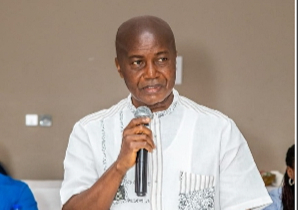Regional News of Thursday, 2 October 2014
Source: GNA
Buffer Zone Project starts in Upper East
Mr Asher Nkegbe, Upper East Regional Director of Environmental Protection Agency (EPA), has called for stakeholder support for the implementation of the Buffer Zone Project to help restore lost ecosystem.
Addressing the fourth ordinary session of Bawku West District at Zebilla, he said his outfit is in consultation with the assemblies to galvanise their support for the project.
He implored the assemblies to institute by-laws and sensitise the communities to get actively involved in the process, since they are expected to play central role in the management of natural resources in their jurisdictions.
He said the EPA and its partners including the Water Resources Commission (WRC), Ministry of Food and Agriculture, Forestry Commission and Food and Agriculture Organisation have set a target to recover 2,000 hectares of buffer zones in the region including parts of West Mamprusi District.
Mr Nkegbe mentioned Yindure, Pwalugu, Santeng and Wuug in the Talensi District, Nangodi spring in Nabdam Distinct, Mognori and Jentiga rivers including the Avdoug stream at Namoog in Bawku all along the White Volta as some of the buffer zones his outfit and partners are working to maintain and restore the ecosystems.
He said the Bachonsa, Wiesi and Gbedembilisi rivers in the Builsa South District linked to river Sissili and the White Volta as well as the Kopeili stream at Takorayire, Gbeduri and Gbane in West Mamprusi District of the Northern Region have been earmarked for riparian area restoration and the work is ongoing.
He said apart from empowering the communities to plant riparian vegetation using native plant species such as vazabila, bul-kingkang, kang sang, pelicy and Gouri as well as mahogany, vertiva grasses and economic trees, various committees have been formed to be responsible for the maintenance, policing and monitoring the incursion of humans into the buffer zones.
“One hundred and three farmers who were farming close to various river banks are now protecting zones that have been created. A100- metre wide riparian belt has been established and this is being protected by prohibition of farming, bush burning, cutting of plants and trees,” Mr Nkegbe said.
He said fire resistant plants like mahogany have been planted along the visually delineated boundaries of the buffer zones, explaining that the natural boundaries would be complemented in the dry season by the construction of fire belts to prevent wild fire from spreading into the area.
The project is being supported by Ghana Sustainable Land and Water Management and Ghana Environmental Management Project, with funding from World Bank and Canada.
The Assistant Basin Officer of WRC in charge of the Region, Mr Joachim Ayiiwe Abungba said the Buffer Zone Policy talks about the prevention of siltation of rivers and dams, avoidance of floods, improvement of irrigation farming, return of endangered species as well as improving upon water tables of rivers.
He said sensitisation and capacity building undertaken by the partners in the various communities, have improved the interest of community members and encouraged them to actively get involved in activities such as the planting of tree species and the management of erosion.
Mr Moses Adukpam, an assemblyman lauded the EPA and its partners for the project.
The Buffer Zone Policy was approved by Cabinet last year and launched this year.
Under the new policy, all water bodies and other natural resources in the 10 regions are to be protected and preserved.










